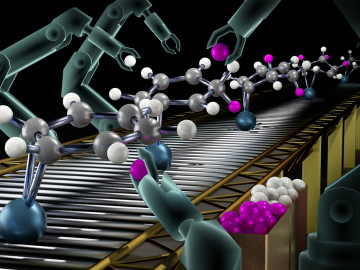
Filter News
Area of Research
- Advanced Manufacturing (8)
- Biology and Environment (36)
- Computational Biology (1)
- Computational Engineering (2)
- Computer Science (6)
- Electricity and Smart Grid (1)
- Energy Science (84)
- Functional Materials for Energy (2)
- Fusion and Fission (9)
- Fusion Energy (7)
- Isotopes (7)
- Materials (64)
- Materials Characterization (2)
- Materials for Computing (12)
- Materials Under Extremes (1)
- Mathematics (1)
- National Security (8)
- Neutron Science (34)
- Nuclear Science and Technology (7)
- Quantum information Science (1)
- Supercomputing (25)
- Transportation Systems (2)
News Type
News Topics
- (-) Artificial Intelligence (33)
- (-) Biomedical (18)
- (-) Composites (16)
- (-) Cybersecurity (9)
- (-) Environment (67)
- (-) Fusion (19)
- (-) Isotopes (15)
- (-) Materials (70)
- (-) Neutron Science (42)
- (-) Physics (11)
- (-) Polymers (15)
- (-) Security (4)
- (-) Transportation (52)
- 3-D Printing/Advanced Manufacturing (57)
- Advanced Reactors (18)
- Big Data (26)
- Bioenergy (26)
- Biology (31)
- Biotechnology (6)
- Buildings (31)
- Chemical Sciences (31)
- Clean Water (14)
- Computer Science (70)
- Coronavirus (15)
- Critical Materials (13)
- Emergency (2)
- Energy Storage (50)
- Exascale Computing (11)
- Fossil Energy (1)
- Frontier (10)
- Grid (28)
- High-Performance Computing (33)
- Hydropower (6)
- Irradiation (3)
- ITER (5)
- Machine Learning (19)
- Materials Science (54)
- Mathematics (3)
- Mercury (3)
- Microscopy (21)
- Molten Salt (6)
- Nanotechnology (25)
- National Security (13)
- Nuclear Energy (36)
- Partnerships (11)
- Quantum Computing (9)
- Quantum Science (18)
- Simulation (16)
- Software (1)
- Space Exploration (11)
- Statistics (1)
- Summit (11)
Media Contacts

Combining expertise in physics, applied math and computing, Oak Ridge National Laboratory scientists are expanding the possibilities for simulating electromagnetic fields that underpin phenomena in materials design and telecommunications.

Burak Ozpineci of the Electrical and Electronics Systems Research Division at Oak Ridge National Laboratory has won the 2020 IEEE Power Electronics Society Vehicle and Transportation Systems Achievement Award.

Researchers at Oak Ridge National Laboratory developed a method that uses machine learning to predict seasonal fire risk in Africa, where half of the world’s wildfire-related carbon emissions originate.

The Department of Energy’s Office of Science has selected three Oak Ridge National Laboratory scientists for Early Career Research Program awards.

Bruce Wilson, a group leader in the Environmental Sciences Division at the Department of Energy’s Oak Ridge National Laboratory, has been elevated to the grade of senior member of the Association for Computing Machinery

Juergen Rapp, a distinguished R&D staff scientist in ORNL’s Fusion Energy Division in the Nuclear Science and Engineering Directorate, has been named a fellow of the American Nuclear Society

Giri Prakash, data informatics scientist and director of the Department of Energy’s Atmospheric Radiation Measurement Data Center at Oak Ridge National Laboratory, has accepted an invitation from the National Academies of Sciences, Engineering, and Medicine to serve a four-year term on the U.S. National Committee for CODATA.

Matthew R. Ryder, a researcher at the Department of Energy’s Oak Ridge National Laboratory, has been named the 2020 Foresight Fellow in Molecular-Scale Engineering.

Scientists have found a new method to strategically add deuterium to benzene, an aromatic compound commonly found in crude oil. When applied to the active ingredient of drugs to incorporate deuterium, it could dramatically improve the drugs’ efficacy and safety and even introduce new medicines.

A multi-institutional research team found that changing environmental conditions are affecting forests around the globe, leading to increasing tree death and uncertainty about the ability of forests to recover.


